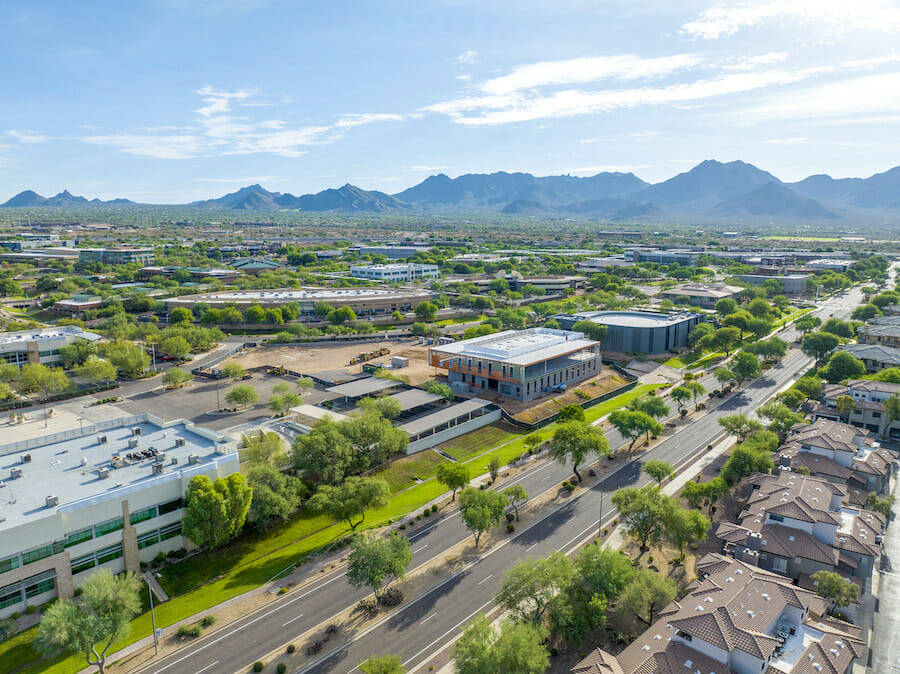LGE Design Build, one of the Southwest’s leading design-build construction firms, released today its third quarter Construction Delivery Outlook report that analyzes trends and data to create Phoenix construction trends and forecasts that are expected to shape and influence the industry into 2023.The report examines obstacles and opportunities in various sectors within construction, including labor, supply chain, material costs and demand.
READ ALSO: Best Places to Work in Arizona: LGE Design Build
“With what is looking like the pandemic now being almost entirely in our rearview mirror, this report’s findings indicate that there are reasons to be optimistic about what is on the horizon,” said David Sellers, the president and CEO of LGE Design Build. “This positive outlook still comes with its fair share of challenges but we are hopeful as the supply chain bottlenecks continue to clear up and the national labor market rebounds. These factors suggest that a recession may not be inevitable, despite the current levels of inflation.”A summary of the Construction Delivery Outlook and Phoenix construction trends include:
Construction Labor
Labor markets continue to present challenges and the effects are being felt across many sectors of the economy. In the construction industry, the unemployment rate has been in steady decline since the height of the pandemic and it is finally below pre-pandemic levels. More positive indicators show that demand for architectural work and construction have been growing. Other notables:
• From April to July 2022, the construction unemployment rate fell from 4.6% to 3.5% which is well below the pre-pandemic mark of 5.5%.
• In July, total construction employment rose by 32,000 hires; however, the nonresidential construction sector has yet to surpass its pre-pandemic levels.
• According to the U.S. Department of Labor, the construction industry is looking to add approximately 650,000 workers in 2022.
• Skilled trades have struggled to fill positions and less than 45,000 apprentices completed their programs in 2021.
• Nearly 90% of construction firms have encountered project delays, with 60% of those firms citing labor shortages as a reason for the delays.
Supply Chain
Recent figures show there is cause to be optimistic about the current conditions of the supply chain. The once “perfect storm” that was causing all the issues seem to be dissipating as shipping delays on water and land are becoming less frequent. Other notables:
• Since the beginning of the year, there has been an 80% reduction in the number of ships that are waiting in U.S. ports.
• Shipping containers are no longer in short supply and there is even a current surplus of approximately 6 million containers across the globe.
• The unemployment rate in the transportation sector fell below pre-pandemic levels in July as it hit 4.2%. In that same month, approximately 3,500 trucking jobs were added.
• The Infrastructure Investment and Jobs Act, which was passed November 2021, could add additional strain to the supply chain on a national level as a provision within the act requires that all materials for roads and bridges be sourced domestically.
• The construction of three semiconductor plants in Arizona have made it difficult for local subcontractors to source materials.
Material Costs
Final construction costs are expected to remain high for at least another quarter, but material costs are expected to decrease even more as additional supply chain solutions are put in place. The cost of steel, specifically, is expected to continue to decrease in cost as the year progresses. Other notables:
• Lumber has been one of the most volatile materials with drastic price fluctuations since September 2020. However, the price of lumber has now lowered 16% over the first half of 2022.
• While flat glass has somewhat stabilized nationally, LGE has seen a staggering 40% increase in the price of glass for storefront systems in the Southwest in the past quarter.
• Prices on steel mill products have dropped more than 14% after spiking drastically in May as demand continues to wane.
Most In-Demand U.S. Markets for Industrial Construction
• There is nearly 44 million square feet of industrial construction taking place in the Phoenix metro area, which is second only to Dallas with just shy of 57 million square feet under construction.
• When it comes to completed projects for the first half of 2022, the Dallas market has delivered 15.9 million square feet, which is considerably higher than the next two markets, Indianapolis and Phoenix, which produced 7.9 and 7.7 million square feet, respectively.
Also of note, the effects of labor issues, supply chain delays and material volatility have been impacting more than just construction teams. Architectural teams have been experiencing long lead times due to the changing expectations of municipalities’ Design Review Boards (DRB), along with prolonged entitlement and permit review processes.To view the data within the Construction Delivery Outlook report and to learn more about Phoenix construction trends, click here. For more information, visit LGEDesignBuild.com.




